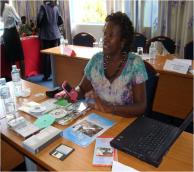I recently finished a chapter for a book to be published by the National Defense University about the persistent problem of information asymmetry in disasters, the condition by which information is disaggregated in such a way that it compounds the already horrendous logistics struggle of humanitarian organizations to provide life-saving aid to victims. Food drops are missed by the general population, the wrong supplies get to the wrong hospital, and water sits on a tarmac rather than getting into the hands of people who are desperate for it. Information asymmetry has two dimensions: the inability to get any data from a lack of access to that information or the inability to take aggregated data and make sense of it all. Often in disasters the first dimension is attributed to a lack of connectivity – whether because of geography or lack of infrastructure (cell phone towers tend to collapse in earthquakes, floods etc.). Six years ago, NetHope and a variety of private sector partners tackled the condition of connectivity in disasters with the creation of the Network Relief Kit (NRK) . The NRK, which fits in a backpack, has a BGAN satellite receiver about the size of a medium-sized textbook. It provides a broadband connection to the Internet, runs off a car battery (or small solar panel) and works almost anywhere on the planet. It has a built-in wireless router for WiFi to support up to ten laptops or Internet phones. So it creates a fast, temporary but crucial voice and data communications hub for a small group of fieldworkers when they need it most immediately – in emergencies.
While the NRK does amazing job of connecting, there are some disasters where the lack of connectivity is compounded in places (like Myanmar after Cyclone Nargis or today’s current conflict in Libya) where autocratic regimes have “shut down” the telecommunications infrastructure or restricted access to journalists. It becomes a situation of not just being able to get public information out but a condition of not being able to get any information at all. As we have seen over the last few weeks, when networks or communication is shut down people revert old network connections (mesh or dial-up) in order to harness new platforms– Twitter, Facebook and other social media – to subvert these network shutdowns. It’s outstanding ingenuity – voice to Tweet for example – and innovation that is providing us with a slew of crisis data. So now we have the information but what do we do with the data? This is the second dimension of information symmetry.
This weekend I met with Gisli Olafsson, NetHope’s Emergency Response and Preparedness Director, as we were both speaking at Harvard for separate events (who knew Harvard was the hotbed of technology, connectivity and enterprise). Gisli, whose blog on disaster response is a great read for anyone interested in this space, told me about the efforts of NetHope, OCHA, and countless other organization and volunteers around the world. Spread across the globe, connected by technology and social media this group is monitoring social media, mainstream media and response organization reports for updates on the terrible situation in and around Libya. I remember this group well from my time in Haiti almost a year ago. Following the devastating earthquake in Haiti this volunteer community rose up to try to help in their own way the people affected by that terrible disaster. Thus was born a new opportunity to improve situation information management that leveraged the human capital of countless volunteers around the world to tackle the very sticky problem of information asymmetry.
 The efforts of this group (OCHA, UNOSAT and NetHope have been collaborating with the Volunteer Technical Community (VTC) specifically CrisisMappers, Crisis Commons, Open Street Map, and the Google Crisis Response Team over the past week) are available now for the public here. For the general public this is a fascinating look at the revolution of connectivity, technology, social media in reporting and responding to one of today’s most pressing global crisis’. For the people of the UN and its agencies, NetHope’s 32 international NGOs and countless others who are responding to the crisis this information provides the pivot point for rapid response and an important tool in overcoming the persistent condition of information symmetry. As this movement gains stream and structure the chapter I wrote less than six months ago may become a bookmark of the past as we begin to stage our response and resources in a way that saves countless lives – but hey I’m not going to feel too bad about my outdated chapter because that is the pace of innovation coupled with the persistence of the human spirit.
The efforts of this group (OCHA, UNOSAT and NetHope have been collaborating with the Volunteer Technical Community (VTC) specifically CrisisMappers, Crisis Commons, Open Street Map, and the Google Crisis Response Team over the past week) are available now for the public here. For the general public this is a fascinating look at the revolution of connectivity, technology, social media in reporting and responding to one of today’s most pressing global crisis’. For the people of the UN and its agencies, NetHope’s 32 international NGOs and countless others who are responding to the crisis this information provides the pivot point for rapid response and an important tool in overcoming the persistent condition of information symmetry. As this movement gains stream and structure the chapter I wrote less than six months ago may become a bookmark of the past as we begin to stage our response and resources in a way that saves countless lives – but hey I’m not going to feel too bad about my outdated chapter because that is the pace of innovation coupled with the persistence of the human spirit.














































